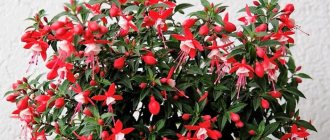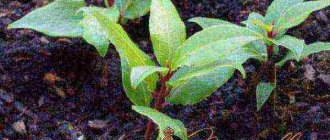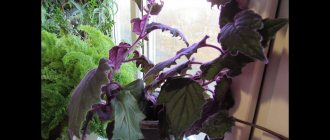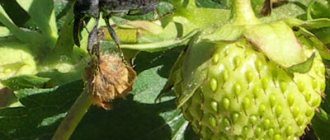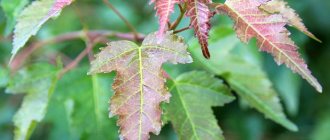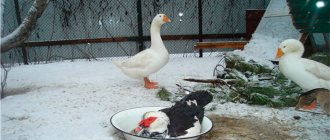Despite the very short moment of existence of the blossoming buds, Ruellia attracts its fans with its neat appearance, long flowering and beautiful velvet leaves.
It is rarely found in flower shops, and the more valuable it is to meet it.
This picky guest from the tropics of South America is worthy of attention, so we will tell you more about her.
Area and appearance features of Ruellia
The main habitats of ruellia, or dipteracanthus, are the tropical jungles of South America. Some species inhabited the tropics of Asia and Africa. Member of the Acanthus family. The name is derived from the surname of Jean Ruel , a French botanist who lived during the Middle Ages.
Among the 250 species, the overwhelming majority of individuals are herbaceous plants , but there are also shrubs (up to 2 meters in height), semi-shrubs, and creeping varieties.
As can be clearly seen in the photo, the leaves of the flower are elongated, with a velvety surface. The color palette of the leaves is represented by light and dark green tones . On the upper part of the leaf blade of variegated varieties, veins of whitish shades stand out. In shrub species, the stems are branched and erect.
For several months a year, Ruellia pleases the eye with its lush blooms. The corollas flash on the bushes every day, but quickly fall off, giving way to their fellows. The color of the flowers is dominated by pink and lilac tones . They have a small diameter, but an impressive length - up to 12 cm.
Botanical description
The Ruellia plant in nature is represented by shrubs, subshrubs and herbaceous perennials with a creeping, faceted and branched stem, on which usually entire elongated leaves are located opposite. The leaf plate of ruellia can be glossy or velvety, covered with barely noticeable lint. At the ends of the shoots, single white, beige or purple-pink flowers are formed, reaching a length of 5 cm and lasting only a few hours. In place of the withered flower, a box appears, which, after ripening, bursts, scattering ruellia seeds over considerable distances.
Types of Ruellia with photos and descriptions
More than 250 species of Ruellia grow in the natural conditions of tropical forests, and only a small part of them are suitable for growing indoors. We bring to your attention the most interesting views with photos.
Britton's (Ruellia brittoniana)
One of the rare representatives of the species in which straight, woody stems grow straight upward. Their length reaches 90 cm. The leaves of Ruellia Brittona are narrow, but long, colored dark green . Under bright sun they take on a bluish tint. The flowers are blue or purple, the diameter of one flower is 6 cm.
Devo (devosa), or blue ruellia (Ruellia devosianus)
Low, up to 40 cm, devo (blue ruellia) needs high humidity. It has beautiful elliptical leaves (up to 7 cm long), painted green on the outside, the lower part of the plate is purple, and there are whitish veins running along it. The corollas are light lilac.
Portella (Ruellia portellae)
Portella lies with its stems on the ground. They have nodes that, in contact with the soil, take root and increase the colonization area. On the dark green leaves of the flower there is a clearly visible white central vein and small tendrils extending from it. The leaves are red on the underside. Produces bright pink buds.
Makoya (Ruellia makoyana)
An erect shrub up to 60 cm high. The crown is branched, the leaves are elongated, decorated with yellow veins on top and purple fibers below. Large burgundy flowers add decorative value to the bush.
Caroline (Ruellia caroliniensis)
Carolina ruellia is a creeping species with densely pubescent stems. The dark green leaves are diluted with beautiful salad veins. The corollas are lilac.
Large-flowered (Ruellia macrantha)
A tall shrub with stems up to 2 meters high and ellipsoidal leaves up to 10–15 cm long. The tubular shape of the corolla gives the flowers a bell shape. The color of the petals contains pink, red and lilac tones.
Interesting! By providing the flower with additional lighting, you can extend its flowering into autumn and winter.
Planting and caring for Mexican petunia
Caring for Mexican petunia at home begins with the correct selection of soil. Ruellia will not grow in heavy clay soil ; it needs loose, well-permeable soil. Experienced flower growers create the substrate for capricious exotics themselves . In percentage terms, the proportions of the mixture components are as follows:
- 20% each of garden soil and coarse river sand (or perlite);
- 25% peat;
- 35% leaf soil.
Location, temperature, lighting
If the windows face different sides of the world, it is preferable to place the flower during the growing season on a western or eastern window . There he is naturally protected from the deadly midday rays of the sun. On the south side, the pet requires shading - it is better to move it there in winter, if possible.
If the lighting regime is not balanced and the plant does not have enough light, it will begin to reach for it, increasing the length of the shoots and losing its decorative effect.
View this post on Instagram
Posted by Angels and Demons (@angeli_and_demoni) Oct 25, 2019 at 6:48 am PDT
Comfortable summer temperature for ruellia is 20...25 °C . If the summer is hot, you need to make an effort to increase the humidity. You can take the flower out into the fresh air, but be sure to cover it from drafts.
Winter temperature limits remain the same, but a decrease to 18 °C will not have a negative effect on the plant.
Attention! Ruellia should not be kept in the kitchen or in a room where people often smoke. The plant suffers from smoke and grows poorly.
Watering and humidity
The need for high humidity is due to the tropical origin of Ruellia. It cannot exist in dry air. It’s great if you have an aquarium in your house: place a pot with a flower not far from it. Using a humidifier and frequent spraying of the plant will also help . It is especially important to monitor humidity in winter, when heating devices dry out the air.
Watering is distributed so as to prevent the soil from completely drying out. Only the top layer may dry out slightly. During flowering periods, watering is intensified so that the soil is always slightly moist.
The average frequency of watering in summer is 2-3 times a week, in winter - 1 time per week . Water the flower with soft, settled water.
How and what to feed ruellia?
Feeding is required from spring to autumn, when the plant is actively developing. For feeding, it is better to take complex liquid fertilizers, applying them once every 14 days. There is no need to feed Ruellia in winter.
Transfer
In order to renew the soil and increase its area for the root system, young ruellia are replanted every year. The difference in volume between the new and old pot should be negligible. Flowers older than 3 years are replanted less frequently , based on the size of the root system.
On a note! If the pot is too big, the ruellia will actively grow roots and stop blooming.
Trimming
Pruning is needed to increase the splendor and decorativeness of ruellia bushes. It is carried out in the spring, removing damaged, strongly elongated and dried shoots. When forming the crown, healthy branches that will serve as cuttings are also pruned .
Transplantation and fertilizing
Young plants need to be replanted every year, adult plants - if necessary (when the pot becomes too crowded). The best time is from March to the end of May. The new container should be only 5 - 7 cm larger than the old one. A tight pot promotes abundant flowering.
Make holes in the bottom to allow excess moisture to escape. Use vermiculite as drainage (3 cm layer). Replant the flower only by transshipment, so as not to disturb the sensitive roots. The substrate should be light, well permeable to air and moisture.
This video will tell you how to replant ruellia and transship it:
Suitable for ruellia:
- a soil mixture of turf and leaf soil with the addition of peat and washed sand;
- ready-made soil for violets;
- universal substrate.
During flowering, apply a complex product for ornamental plants. After a short period of adaptation, combined compositions for ornamental plants are added. They usually fertilize once or twice a month.
It is also useful to feed with organic and mineral mixtures in equal parts (apply both at the root and at the leaf). The concentration is approximately ¼ less than indicated in the instructions.
Reproduction of Ruellia
All four known methods of plant propagation are excellent for Mexican petunia. Let's look at each of them.
Cuttings of Mexican petunia
The best time to obtain cuttings is the beginning of spring, when preventative pruning of the plant is carried out. Branches 10–15 cm long are cut from healthy shoots . After treating with a growth stimulator, the cuttings are planted in moist soil. They need to be introduced into the soil at a slight angle. Then cover with a transparent plastic container with holes for ventilation.
When the cuttings produce the first leaves, the shelter can be removed. Keep it in the planting container for a few more days so that the leaves grow, and then transplant it into a pot.
By layering
This method is used for varieties with long shoots. Having placed another container with soil next to the plant, the shoot selected for propagation is bent to it and carefully secured with a wire clamp. They continue to care for it like a mother plant. When it becomes clear that the cuttings have taken root, they are cut off from the “donor” .
Growing from seeds at home
It is recommended to use separate plastic cups for planting ruellia seeds:
- Soil and one seed are added to each, deepening it into the soil by about half a centimeter.
- Moisten the soil and cover with film.
- For successful germination, seeds need a temperature of around 24 °C.
Planting care consists of regular watering and ventilation. The sprouts are kept in greenhouse cups until they produce three strong leaves, only then they are transferred to a normal pot.
Dividing the bush
Those plants that have young shoots are divided. It is not recommended to divide large bushes with a single root system . Sometimes young shoots come from fallen seeds. When cutting off shoots from the mother bush, be sure to treat the cuts with charcoal.
Useful reviews about growing Ruellia
I have had Ruellia Devo for 10 years now, and I have given her children to all my friends. I planted 2 bushes in a hanging basket and it looks very good in the summer. I cut off the branches for the winter. A very responsive plant to rich soil and fertilizing. I hang it on the north side. The flowers are short-lived: they bloom in the morning and fall off in the evening.
Lelka
https://frauflora.ru/viewtopic.php?t=7572
A stunningly unpretentious plant!
It will look better in a pot if there are a lot of them planted. To do this, you can root cuttings and crowns in a glass of water. There are fewer flowers on older branches. It will bloom when the pot becomes too small. It is easily propagated by seeds, but before ripening, you need to put a small gauze bag on the testis, because he shoots seeds all over the room. If the seeds are not needed, then you can cut them off. Galinka https://forum.bestflowers.ru/t/ruehllija.23866/
I remember when I had ruellia (though I didn’t know its name then), its seeds sprouted all over my apartment in all the pots! I don’t know how far she shoots them, but the wind carries them well, and right into other pots. So there was no need for rooting, the main thing was that it bloomed, and then you know, weed its numerous settlements
As for growing conditions: it grew in diffused light, near a southern window in Central Asia.
That is, it is warm and light enough, but it has never withstood direct sunlight. leshj https://iplants.ru/forum/index.php?s=bce6b5d258740ddd45ce3adb6c9cf643&showtopic=15936&st=15
...Ruellia is fluffy, so I don’t spray it;
Ruellia grows in a small yogurt cup and is enough for her; there are no plums (holes) in the glass due to the fact that Ruellia is a water-drinking plant; ruellia very easily and quickly gives roots in water - I was given 2 branches each 3 cm in size! and they quickly took root and began to grow, and having reached a size of about 7 cm, released buds and bloomed; Ruellia is standing by the window at eye level (an old refrigerator), there is no direct sun, it’s bright! Half-day flowers are light blue. I don't know the variety. Ruellia seeds are round, about 1.5–2mm flat (see photo), cracking all over the kitchen! but they have never sprouted anywhere in other pots! Once I opened a brown box myself and sowed the seeds in the same glass - the result is in the photo - which means they need moisture, without a greenhouse and without a “cap”! there was no need to cover it with soil, the seeds were just lying on the ground. NadinA https://iplants.ru/forum/index.php?showtopic=15936&st=45
I had ruellia, but it disappointed me with a loose bush that did not want to be neat and compact.
It was only later that I read that it needs to be pruned twice during the summer and that it is better to grow it as a hanging plant. In general, I sent him to the child’s kindergarten. Although the plant is generally cute... Anna Malik https://www.lepestok.kharkov.ua/forum/viewtopic.php?t=910
Why ruellia does not bloom and other care mistakes
A common reason for the failure of Ruellia to bloom is a poorly organized dormant period. If it takes place at high temperatures, the plant does not form flower buds . Dry air and lack of lighting also negatively affect flowering.
Other problems:
- Leaf wilting occurs when the soil is too dry.
- With a lack of light, Ruellia leaves lose color and decrease in size.
- When the light is too bright, the green leaves turn purple.
- Lack of moisture causes leaf tips to curl.
Diseases and pests of Mexican petunia
With low humidity, spider mites may appear on the flower, which loves dry air and succulent leaves of plants. Treating the infected parts with a soap solution helps rid the flower of it.
If you notice a scale insect or whitefly on your pet, collect the insect larvae and treat the ruellia with insecticides.
Important! Maintaining high humidity will prevent attacks by harmful insects.
Ruellia can get fusarium . A sign of the disease is the appearance of brown and yellow spots on the leaves. The development of the disease leads to rotting of the roots and stems; treatment consists of the use of fungicides.

